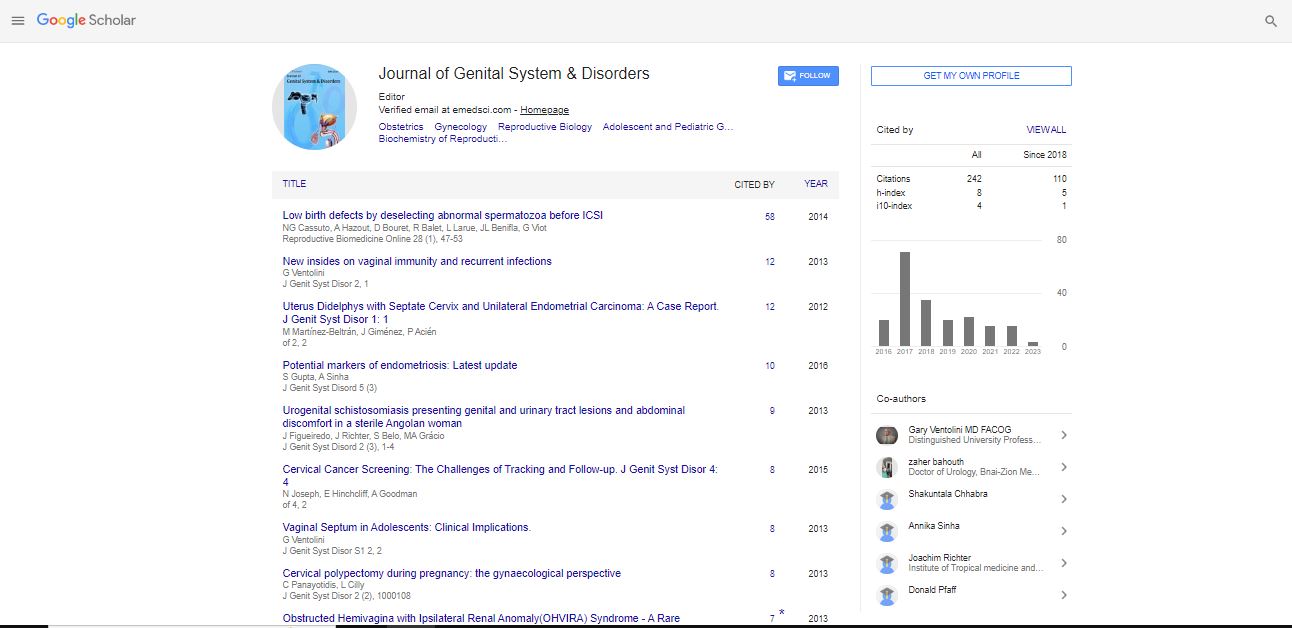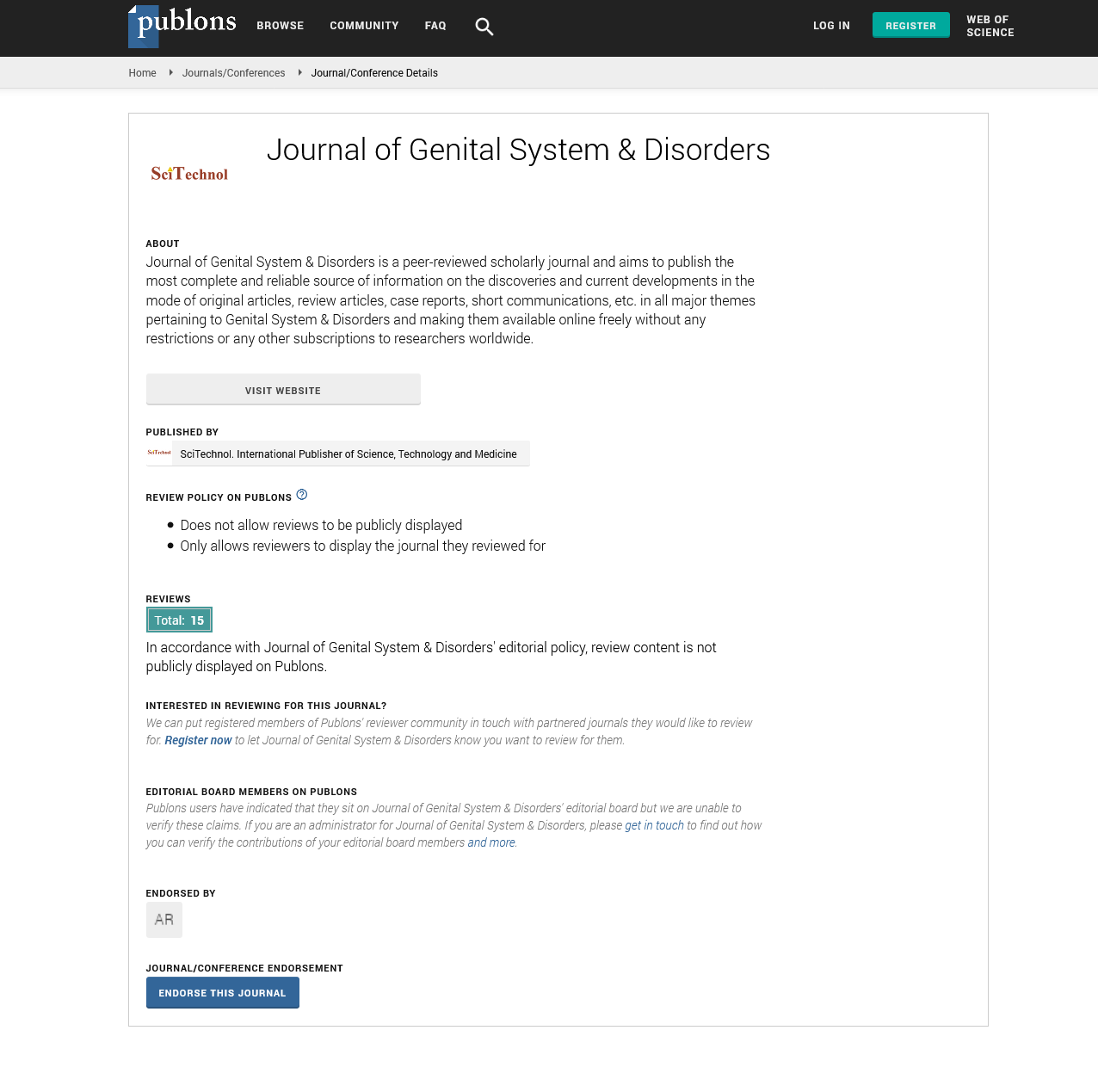Editorial, J Genit Syst Disord E Vol: 9 Issue: 3
Swamp Wallabies Can Have Two Separate Pregnancies at Once and also Genetic Risk Factor for Erectile Dysfunction Identified
Atef Darwish*Department of Obstetrics and Gynecology, Assiut University, Egypt
*Corresponding Author: Atef Darwish
Department of Obstetrics and Gynecology, Assiut University, Egypt
E-mail: atefdwar@gmail .com
Received date: November 05, 2020; Accepted date: November 19, 2020; Published date: November 25, 2020
Citation: Darwish A(2020) Swamp Wallabies Can Have Two Separate Pregnanciesat Once and also Genetic Risk Factor for Erectile Dysfunction Identified. J Genit Syst Disord 9:3.
Marsh wallabies can have two concurrent pregnancies at various phases of development, demonstrating a one of a kind strategy for mammalian multiplication that leaves them ready to be pregnant and lactating for their whole regenerative carries on with, as indicated by an investigation distributed Monday (March 2) in PNAS. The ebb and flow study affirms what many had since quite a while ago suspected, that swamp wallabies (Wallabia bicolor) can be pregnant in both of their uteruses simultaneously, considering a second undeveloped organism days before the first is born.As Smithsonian Magazine brings up, while the European earthy colored rabbit (Lepus europeaus) is additionally ready to have covering pregnancies, it is limited to a reproducing season. The marsh wallaby doesn't have this imperative, taking into consideration inconclusive pregnancies all through its regenerative life. Kangaroos and different wallabies additionally have two uteruses, yet they are not utilized simultaneously."Potentially, these creatures are consistently pregnant," lead creator Brandon Menzies discloses to The New York Times. Analysts noted around 50 years back that swamp wallabies will in general mate in late phases of pregnancy, offering ascend to the theory that pregnancies could cover. The ebb and flow study coaxed out the subtleties by performing customary ultrasounds and vaginal swabs on female marsh wallabies, looking for indications of sex. Nine out of 10 pregnancies highlighted both uteruses being used and practically all couplings happened in the last long periods of pregnancy. The new incipient organism enters diapause, permitting its more seasoned kin to be conceived and move to the mother's pocket. This inactivity keeps going a while until the more established joey starts to wean, flagging that the time has come to proceed with advancement. At that point, half a month later, the hatchling is conceived and another pregnancy has just begun.
Amazing the birth plan permits the mother to time the joey's improvement with the aid of grass that shows up each spring so that once they arise nine months after the fact from the pocket, there is bounty to eat and the youthful wallaby has its most obvious opportunity with regards to progress. "The female regenerative body is astonishing," Ava Mainieri, a transformative scientist at Harvard University who was not associated with the examination, discloses to Smithsonian. "Any system a [female body] can gain by . . . to expand her wellness, she will use."Many questions stay with regards to why swamp wallabies imitate thusly, given the way that they just conceive an offspring once every year and this methodology doesn't support the general number of births the mother could have over her lifetime.
It would likewise seem, by all accounts, to be vivaciously burdening for a female to be ceaselessly pregnant and lactating. The scientists guess that it very well may be because of an absence of mate accessibility consistently, Menzies tells Smithsonian. "Bog wallabies are in reality extremely single," Menzies discloses to the Times. "We thought, perhaps the marsh wallaby is pushing estrus back into pregnancy so it has a more drawn out time of receptivity to locate a male in nature." Understanding the components behind this remarkable cycle might offer ascent to better approaches for moving toward human fruitfulness and the endocrinology of pregnancy. "In the event that we could resolve this intricate cycle, we might not need to cryopreserve undeveloped organisms, yet rather keep them in balance inside the research center," David Gardner, who concentrates in vitro treatment at the University of Melbourne and was not engaged with the investigation, reveals to National Geographic. "There's such a great amount of still to gain from marsupials."
Hereditary elements represent around 30% of the danger for erectile brokenness, twin examinations have shown, yet as of not long ago, no particular loci had been distinguished. In an investigation distributed for the current week (October 8) in PNAS, analysts have, through genomewide affiliation considers (GWAS), discovered such a danger factor at a locale almost a quality called SIM1, which they call the SIM1 locus. "Recognizing this SIM1 locus as a danger factor for erectile brokenness is serious in light of the fact that it gives the since quite a while ago searched after verification that there is a hereditary segment to the sickness," lead creator Eric Jorgenson, an analyst at Kaiser Permanente Northern California, says in a public statement. "Distinguishing the principal hereditary danger factor for erectile brokenness is an energizing disclosure since it opens the entryway for examinations concerning new, hereditary based treatments." The recently recognized danger factor is a solitary nucleotide polymorphism (SNP) on chromosome 6. Having a thymine (T) nucleotide at this position builds the danger of erectile brokenness by around 25 percent, the scientists found, in the wake of considering other danger factors for the problem. "We realize that there are other danger factors for erectile brokenness, including smoking, heftiness, diabetes, and cardiovascular sickness," Jorgenson tells Newsweek. "What is striking about the area in the human genome that we distinguished is that it demonstrations freely of these realized danger factors. That is, this hereditary area seems to act explicitly on sexual capacity."
Jorgenson and associates distinguished the locus through a GWAS of 36,649 men from a Kaiser Permanente information base. When they recognized the spot on chromosome 6 that appeared to be connected with erectile brokenness, they at that point affirmed the relationship in information from 222,358 men from the UK Biobank. The locale of interest contained a few SNPs however just one was developmentally moderated, which is the reason they zeroed in on it, the writers write in their paper. SIM1 encodes a record factor associated with both sexual capacity and body weight guideline, and the creators note that few lines of proof recommend that the SIM1 locus is engaged with managing the quality. The locale that incorporates the danger factor truly associates with the SIM1 advertiser, the scientists found. Results from the ENCODE venture, which attempts to recognize different practical components of the human genome, highlight the locus as an imaginable enhancer, and lab tests affirmed that theory, specifically, that the T allele helps the action of an enhancer directing SIM1, the writers compose. "The subsequent stage is to discover how this area in the genome influences the danger of erectile brokenness," Jorgenson tells Newsweek.
 Spanish
Spanish  Chinese
Chinese  Russian
Russian  German
German  French
French  Japanese
Japanese  Portuguese
Portuguese  Hindi
Hindi 
